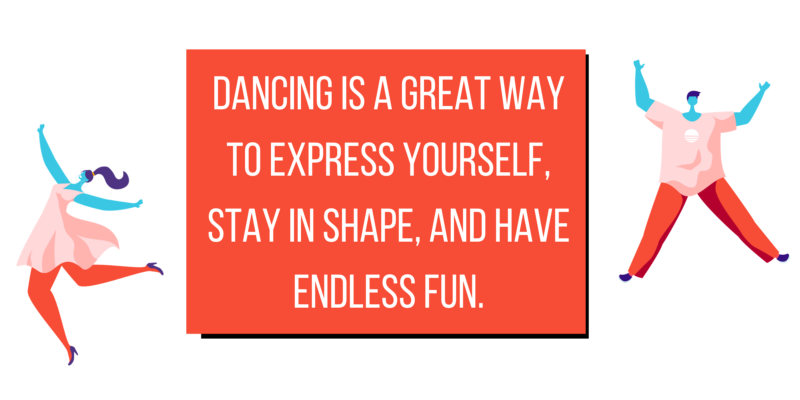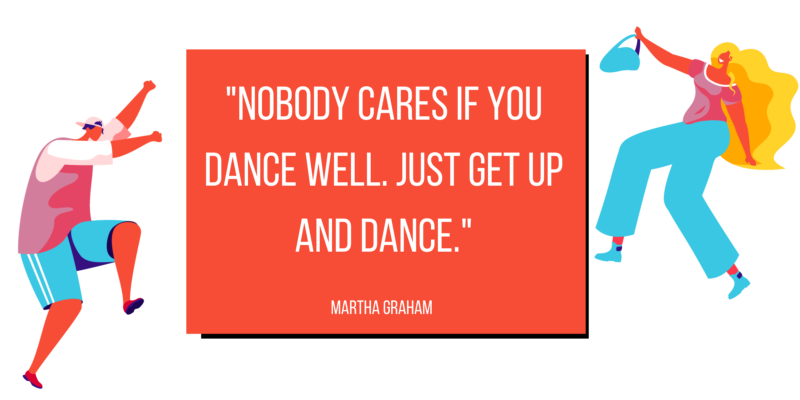People often say they can’t dance. However, there are few things more universal than the instinct to move your body to music that moves you emotionally. All cultures and people have (even if rarely) the inclination to dance when they’re excited by music, or even to the internal rhythms of their bodies.
Dancing publicly, or dancing well is another story. Maybe you’ve been discouraged from dancing due to childhood trauma, limitations in coordination, rhythm, imagination, or just catching sight of your reflection and realizing it doesn’t look how you’d hoped. Regardless, all people can dance, and everyone can learn to be a better dancer.
You have the right to dance, and to enjoy yourself while you do it. If you want to improve as a dancer, you also have many tools at your disposal to help you do precisely that.

Dancing is a great way to exercise, expand your taste in music, develop your coordination and internal rhythm, meet new people, and enjoy unique aspects of different cultures you might know nothing about. For a select few it can also lead to careers as a choreographer, stage manager, instructor, or even professional dancer.
Most of all, learning to dance can dramatically increase your confidence and expand your social life. You’ve been to loud parties, bars, or clubs. These are places where people are supposed to mingle and enjoy the company of strangers. However, striking up a conversation with strangers can be daunting, especially in an environment where it’s hard to hear. In these situations, you might notice people are dancing confidently. These lucky few do so without a care about who’s watching. They can seem genuinely lost in the flow, happy whether they interact with anyone at all. It might be a facade, but losing yourself in music and dance is one of the greatest joys people have ever experienced.
You might have also realized people naturally gravitate towards confident dancers, especially if they’re technically skilled, but not necessarily.
Confidence in dancing and the skills that motivate that confidence can be learned.
There are many different ways to learn to dance. You can practice along while watching people who do it well. You can take a class online. You’ll have ample opportunities to take dance classes locally, wherever you live. And you can get a degree in the field if you realize it’s a lifelong passion.
Let’s check out some of the options in a dancing education, including pros and cons for different methods:
Self-Teaching Yourself to Dance
Dancing is fascinating because it’s an extremely subjective art. If you’re moving to music, or even to the beat in your heart, you’re doing it. However, there are many moves and styles of dance you can learn that will pay dividends throughout your social and personal life. You can enjoy dancing without any formal training, but getting some instruction in it can increase the pleasure you take in it.
Ask yourself, what are you looking for? Do you want to be more confident in social settings? Learn a specific style of dance? Is dancing a fun hobby for you? Do you want to pursue it intently? Do you want a career in dancing? Are you a good dancer and you want to improve, or are you starting from scratch and looking for any improvement.
Answering these questions can help you decide how to learn to dance. Here are a few more to consider:
- What is your dancing experience?
- If you’re starting with some education in dancing, you might opt for a more structured environment to improve. If you have an unexplored love for it or are a self-diagnosed bad dancer, you might want to do some work by yourself. This can be watching Youtube videos, or as simple as picking some of your favorite music and moving to the beat.
- If you’re feeling up to it, going to dance clubs with friends, or trying to mimic what you see from more experienced dancers in dancing environments is a great way to practice.
- Do you want to do choreographed moves or routines? Do you want more confidence making extemporaneous dance moves?
- Deciding this can help you decide whether to take a class or continue practicing at home and in places where people are dancing.
- Would you like to learn a specific style of dance?
- Whether it’s hip-hop, salsa, swing, or any of the other countless styles of dance, you can find videos that will take you from basic fundamentals through advanced routines.
- If you have friends who are good dancers, dancing with them is a great way to train and practice.
- If you’re a competent dancer looking to get better, you want to practice as much as possible by yourself, but preferably with others. The more you see people dance, and immerse yourself in it, then practice what you see, the better you’ll get.
- Do you have ambitions to work in dance?
- Some people are self-taught dancers. However, few of them are employed teaching dance, dancing professionally, or working in an adjacent part of the field like choreography, dance management, or other positions that support dancers.
- If dancing is a passion for you, you can make incredible progress through working on it yourself.
- If you commit to dancing in any way, the more time you put into it, the more you’ll get out.
- Teaching yourself how to dance has its benefits and difficulties:

Pros
- Decide exactly when, what, and how to practice dancing
- Build a hobby for yourself that can develop into something more substantial
- Entirely free
Cons
- Takes self-discipline to improve
- May be limited by the natural talent and experience you bring into DIY dancing
- You could be overwhelmed by the sheer amount of resources and have a hard time deciding which to use
Not-For-Credit Dance Classes
Many dance classes aren’t for credit, they’re for enjoyment and improvement in a specific style of dance. You’ll likely have to pay for any dance class you want to take in-person, but there are some free dance classes you can take, especially in big cities, or others that are provided by grants, government, and other institutions. There are also Meetup.com dance classes, and lessons you can opt for that are free, there are just far fewer of these options. Depending on where you live you can likely find some free dancing and yoga options.
Here are some options to look for
- Let’s say you want to take a dancing class, but aren’t sure which one, or whether you want to commit to weeks or months of a specific class. If you go to dance studios near you and ask them if you can take one class to decide if it’s right for you, you’ll likely find them open to it, either letting you participate for free or for a nominal fee.
- Some studios offer students access to dance classes on a pay what they can basis.
- As previously mentioned, check Meetup.com for local opportunities for free or cheap dance classes.
- Reach out to friends, family, and acquaintances who are more involved in dance and get their opinions on what classes are worth your time and energy.
- Dance studios often do promotions around the holidays and the beginning of the year to entice new students.
- If you want to take an online class, there are some free ones that you find here.
You might also consider a MOOC in dancing or choreography. MOOCs are Massive Open Online Courses that are often free. They’re great for learning about dancing, choreography, yoga, or anything that you want to gain skills and experience in. They don’t require that much time weekly, but offer students access to experts and structured training that can advance their expertise and knowledge in dance, among many other topics.
Pros
- More of a structured approach to dance training
- The opportunity to select a program that fits your lifestyle and interests
- Great way to meet likeminded people who are at the same part of their journey into dance as you are
Cons
- Will likely cost money
- In-person classes meet at scheduled times
- Online courses in dancing are less useful than other disciplines
Dancing Degrees
If you know you love to dance, and want a future in the field, it might make sense to get a dancing degree or certification. Some of the dance degree and certification options are:
- Certificate in Dance Education
- Dance Certificate
- Associate of Arts in Visual and Performing Arts (Dance)
- Bachelor of Arts in Dance
- Bachelor of Fine Arts in Dance
- Master of Fine Arts in Dance
- You might also consider specializations in dance teaching, exercise science, musical theater, theater arts, dance therapy, art therapy, music therapy, or a music or arts education, among many others.
You may find some online options, mostly for dance professionals and educators who want to continue their education. You’ll likely need to do a hybrid of online and in-person training for these programs.
At Degree Query, we’ve done tremendous work to help you find the resources you need to further your education and improve your life. Some of the work we’ve done on dance and related fields includes the following:
- What Can I Do With a Human Development Degree?
- What are the professional organizations for people in Child Development?
- Which Schools Have the Best Master’s Programs in Early Childhood?
- What Are the Differences Between Art Therapy and Music Therapy Degrees?
- What Certifications Do You Need to Become a Music Therapist?
- What Can I Do with a Performing Arts Degree?
- What Can I Do with an Art Therapy or Music Therapy Degree?
- Top 50 Highest Paying Master’s Degrees
